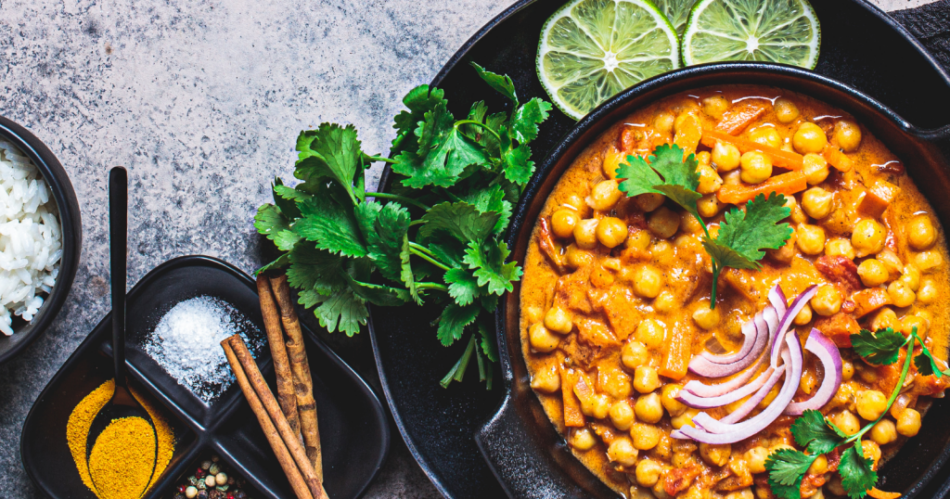There was a stretch of weeks earlier this year when cooking started to feel more like maintenance than joy.
I’d open my fridge, stare at the same prepped tofu and wilted kale, and feel…nothing. My meals were fine—nutritious, balanced—but they didn’t sing.
Then one night, I reached for a forgotten jar of turmeric. I tossed a pinch into a pan of chickpeas sizzling with garlic, and the kitchen came alive.
The air filled with warmth, the color deepened to gold, and suddenly, I remembered why I fell in love with cooking in the first place.
That was the spark that led me back to spices—and specifically, to curries. Comforting yet complex, humble yet global, curry became my culinary reset button.
Over the next few months, I experimented with dozens of versions, from creamy coconut chickpeas to bright Thai green curry to meditative red lentil masala.
Each one taught me something—not just about flavor, but about presence.
Here are the three recipes that helped me fall in love with spices again (and might just do the same for you).
1. Coconut chickpea curry (the weeknight healer)
There’s a reason this one became my Tuesday-night ritual. It’s the perfect blend of creamy, cozy, and simple—a dinner that asks very little of you and gives so much back.
Why it works: chickpeas add a solid plant-based protein foundation, coconut milk brings soothing richness, and warm spices like cumin and turmeric build quiet depth.
And here’s the kicker: warm, familiar flavors—the kind found in your favorite comfort foods—can actually help calm your mind and melt away stress. So yes, your cozy curry night really does count as self-care.
Ingredients (serves 4)
- 1 Tbsp coconut oil
- 1 yellow onion, finely chopped
- 3 garlic cloves, minced
- 1 Tbsp freshly grated ginger
- 1½ tsp ground cumin
- 1 tsp ground coriander
- 1 tsp turmeric
- ½ tsp smoked paprika
- 1 (15-oz) can crushed tomatoes
- 1 (15-oz) can coconut milk (full-fat for extra creaminess)
- 1 (15-oz) can chickpeas, drained and rinsed
- 1½ tsp sea salt (or to taste)
- Juice of ½ lime
- Fresh cilantro and cooked basmati rice, to serve
Instructions
- Start with the base. Heat coconut oil in a large pan over medium heat. Add the onion and cook until translucent, about 5–6 minutes.
- Add the aromatics. Stir in garlic and ginger and cook for another minute.
- Toast the spices. Sprinkle in cumin, coriander, turmeric, and paprika. Stir for 30 seconds to bloom the flavors.
- Build the sauce. Pour in crushed tomatoes and simmer for 5 minutes.
- Bring it together. Add coconut milk and chickpeas. Stir, cover, and simmer for 10–12 minutes until thickened and golden.
- Finish strong. Stir in lime juice and salt to taste.
- Serve over rice with cilantro.
Pro tip: Refrigerate overnight—this curry tastes even better the next day as the spices deepen and meld.
Flavor psychology:
Creamy textures and warm spices create a sensory “comfort loop,” signaling safety and satisfaction. That’s why you’ll instinctively slow down while eating this—it gives your nervous system permission to exhale.
2. Thai green curry with tofu and vegetables (the creative recharge)
After a month of mellow flavors, I craved something bright—something that woke me up. Thai green curry did exactly that. It’s a dish that hums with color, from jade-green sauce to vibrant vegetables.
Why it works: The combination of chili heat, lime tang, and fresh herbs activates your senses in every direction. Spicy and tangy flavors naturally wake up your senses, turning an ordinary meal into something that feels vibrant, fresh, and alive again.
This curry isn’t just dinner—it’s edible adventure.
Ingredients (serves 4)
- 1 Tbsp coconut oil
- 1 block extra-firm tofu, pressed and cubed
- 1 small eggplant, cubed
- 1 red bell pepper, sliced
- 1 cup snap peas or green beans
- 2 Tbsp vegan Thai green curry paste
- 1 (14-oz) can coconut milk
- ½ cup vegetable broth
- 1 Tbsp soy sauce or tamari
- 1 tsp coconut sugar
- Juice of 1 lime
- Handful of fresh Thai basil leaves (or regular basil)
- Cooked jasmine rice or rice noodles, to serve
Instructions
- Crisp the tofu. Heat coconut oil in a large skillet over medium-high heat. Add tofu cubes and pan-fry until golden on all sides, about 6–8 minutes. Remove and set aside.
- Sauté the veggies. In the same pan, add eggplant and bell pepper. Cook for 4–5 minutes until softened.
- Add the paste. Stir in the green curry paste and fry for 1 minute until fragrant.
- Make the sauce. Pour in coconut milk, vegetable broth, soy sauce, and coconut sugar. Stir well and bring to a gentle simmer.
- Combine. Add tofu and snap peas. Simmer for another 5 minutes, just until the peas are bright green.
- Finish. Stir in lime juice and basil leaves. Serve over jasmine rice or noodles.
Pro tip: For extra body, stir in 1 Tbsp of peanut butter during the simmer—it adds a subtle nuttiness that balances the curry’s brightness.
Flavor psychology:
Spicy, citrusy dishes like this one can actually trigger dopamine release—your brain’s “motivation” chemical. So if you’ve been feeling uninspired, try a bowl of this. It’s not just nourishment; it’s a creativity reboot.
Planet bonus:
Opt for local or seasonal vegetables—swapping snap peas for green beans or zucchini—to cut down your food miles. Spices travel well; your produce doesn’t have to.
3. Red lentil masala (the meditative batch-cook)
Some recipes remind you that cooking can be as therapeutic as meditation. This red lentil masala is that kind of dish.
As it simmers, the lentils dissolve into silky comfort. The kitchen smells like ginger, cumin, and earth. You stir, taste, adjust—it’s repetitive, grounding, and oddly peaceful.
Why it works: Red lentils cook quickly but give slow-simmer flavor. They’re rich in fiber, iron, and plant protein, and they absorb spices beautifully.
And here’s something interesting: a 2024 study in Nutrients found that participants in a virtual plant-based cooking program experienced lower stress levels and improved mood—proof that time in the kitchen can be its own quiet form of mindfulness.
Ingredients (serves 6)
- 1 Tbsp neutral oil (like avocado or sunflower)
- 1 large onion, chopped
- 3 garlic cloves, minced
- 1 Tbsp grated ginger
- 2 tsp garam masala
- 1 tsp turmeric
- 1 tsp ground cumin
- ½ tsp chili powder (optional)
- 1½ cups red lentils, rinsed
- 1 (14-oz) can diced tomatoes
- 4 cups vegetable broth
- ½ tsp salt (adjust to taste)
- ½ cup coconut milk (optional, for creaminess)
- Fresh cilantro and lemon wedges, to serve
Instructions
- Sauté the base. Heat oil in a large pot over medium heat. Add onion and cook until softened (about 6 minutes).
- Layer the flavor. Stir in garlic, ginger, and spices. Toast for 30 seconds until fragrant.
- Add the lentils and liquids. Stir in rinsed lentils, diced tomatoes, and broth. Bring to a gentle boil, then reduce heat.
- Simmer mindfully. Cook uncovered for 20–25 minutes, stirring occasionally, until the lentils are tender and the texture turns creamy.
- Finish with richness. Stir in coconut milk and salt. Taste and adjust seasoning.
- Serve warm with lemon wedges and cilantro.
Pro tip: Batch-cook this and freeze it in glass jars—it reheats beautifully and the flavors deepen with time.
Flavor psychology:
The steady rhythm of stirring and the repetitive scents of spice can shift your nervous system from “fight or flight” to “rest and digest.” In a world of notifications, this curry invites you to slow down and stir on purpose.
The bigger “why”: falling back in love with flavor
Cooking vegan can sometimes drift into routine. You find your handful of go-to meals and coast.
But spices—those tiny seeds and powders from across the globe—are reminders that comfort and curiosity can coexist.
From a sustainability angle, spices are pound-for-pound one of the most efficient ways to transform plant-based staples into global experiences.
You can eat chickpeas five nights a week and never get bored if you rotate your spice palette: Indian, Thai, Moroccan, Ethiopian, Caribbean—the options are endless.
And when you buy consciously—look for fair-trade or organic spices—you’re supporting smallholder farmers who preserve biodiversity and heritage crops.
Spices like turmeric, cardamom, and black pepper all play vital roles in sustaining ecosystems where monocultures threaten balance.
So yes, your curry night is also a climate action.
Spice confidence roadmap
If you’ve been afraid to experiment, start here:
- Pick three base spices. Cumin, turmeric, and coriander cover 90% of curry needs.
- Bloom them in oil. Always cook your spices in a little fat before adding liquid—it releases their aromatic compounds.
- Layer with acid. Lime, lemon, or tomato brightens everything.
- Balance with sweetness. A touch of coconut milk, sugar, or carrot offsets spice bitterness.
- Taste often. You’ll learn more by adjusting mid-recipe than by following a strict formula.
Closing reflection: when cooking becomes connection
Somewhere between toasting cumin seeds and stirring coconut milk into gold, I realized spices aren’t just flavor—they’re rhythm.
They’re reminders that the best meals aren’t rushed, they’re felt.
Cooking curry became my form of meditation.
I stopped chasing new recipes and started paying attention—to scent, to texture, to how a dash of turmeric can turn an ordinary Tuesday into something worth remembering.
And maybe that’s the quiet lesson in all of this: when you cook slowly, you waste less, taste more, and connect deeper—not just to your food, but to yourself, and to the planet we’re all trying to nourish.
What’s Your Plant-Powered Archetype?
Ever wonder what your everyday habits say about your deeper purpose—and how they ripple out to impact the planet?
This 90-second quiz reveals the plant-powered role you’re here to play, and the tiny shift that makes it even more powerful.
12 fun questions. Instant results. Surprisingly accurate.








